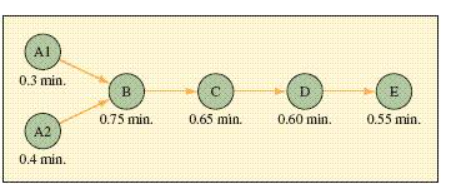Question
1. The Goodparts Company produces a component that is subsequently used in the aerospace industry. The component consists of three parts (A, B, and C)
1. The Goodparts Company produces a component that is subsequently used in the aerospace industry. The component consists of three parts (A, B, and C) that are purchased from outside and cost 40, 35, and 15 cents per piece, respectively. Parts A and B are assembled first on assembly line 1, which produces 140 components per hour. Part C undergoes a drilling operation before being finally assembled with the output from assembly line 1. There are, in total, six drilling machines, but at present only three of them are operational. Each drilling machine drills part C at a rate of 50 parts per hour. In the final assembly, the output from assembly line 1 is assembled with the drilled part C. The final assembly line produces at a rate of 160 components per hour. At present, components are produced eight hours a day and five days a week. Management believes that if the need arises, it can add a second shift of eight hours for the assembly lines.
The cost of assembly labor is 30 cents per part for each assembly line; the cost of drilling labor is 15 cents per part. For drilling, the cost of electricity is one cent per part. The total overhead cost has been calculated as $1,200 per week. The depreciation cost for equipment has been calculated as $30 per week.
a. Determine the process capacity (number of components produced per week) of the entire process.
b-1. Suppose a second shift of eight hours is run for assembly line 1 and the same is done for the final assembly line. In addition, four of the six drilling machines are made operational. The drilling machines, however, operate for just eight hours a day. What is the new process capacity (number of components produced per week)?
b-2. Which of the three operations limits the capacity?
multiple choice 1
- Drilling machines
- Final assembly line
- Assembly line 1
c-1. Management decides to run a second shift of eight hours for assembly line 1, plus a second shift of only four hours for the final assembly line. Five of the six drilling machines operate for eight hours a day. What is the new capacity?
c-2. Which of the three operations limits the capacity?
multiple choice 2
- Assembly line 1
- Final assembly line
- Drilling machines
d-1. Determine the cost per unit output for part b. (Round your answer to 2 decimal places.)
d-2. Determine the cost per unit output for part c. (Round your answer to 2 decimal places.)
2 A. The product is sold at $4.00 per unit. Assume that the cost of a drilling machine (fixed cost) is $30,000 and the company produces 8,000 units per week. Assume that four drilling machines are used for production. If the company had an option to buy the same part at $3.00 per unit, what would be the break-even number of units? (In your calculations, use the two-digit cost per unit from page d-1. Round your answer to the nearest whole number.)
The following diagram represents a process where two components are made at stations A1 and A2 (one component is made at A1 and the other at A2). These components are then assembled at station B and moved through the rest of the process, where some additional work is completed at stations C, D, and E.
Assume that one and only one person is allowed at each station. Assume that the times given for each station represent the amount of work that needs to be done at that station by that person, with no processing time variation. Assume that inventory is not allowed to build in the system.
 B. What is the average hourly output of the process when it is in normal operation?
B. What is the average hourly output of the process when it is in normal operation?
3. A An assembly line is to operate eight hours per day with a desired output of 240 units per day. The following table contains information on this products task times and precedence relationships:
| TASK | TASK TIME (SECONDS) | IMMEDIATE PREDECESSOR |
| A | 60 | |
| B | 80 | A |
| C | 20 | A |
| D | 50 | A |
| E | 90 | B, C |
| F | 30 | C, D |
| G | 30 | E, F |
| H | 60 | G |
B. What is the workstation cycle time?
C. . Balance this line using the longest task time. (Leave no cells blank - be certain to enter "0" wherever required.)
d. What is the efficiency of your line balance? (Round your answer to 1 decimal place.)
A1 0.3min. B C D E A2 0.75min.0.65min.0.60min.0.55min. 0.4min
Step by Step Solution
There are 3 Steps involved in it
Step: 1

Get Instant Access to Expert-Tailored Solutions
See step-by-step solutions with expert insights and AI powered tools for academic success
Step: 2

Step: 3

Ace Your Homework with AI
Get the answers you need in no time with our AI-driven, step-by-step assistance
Get Started


